Public Art Proposal Display
Upwelling
Walter Kitundu (Kitundu Studio)
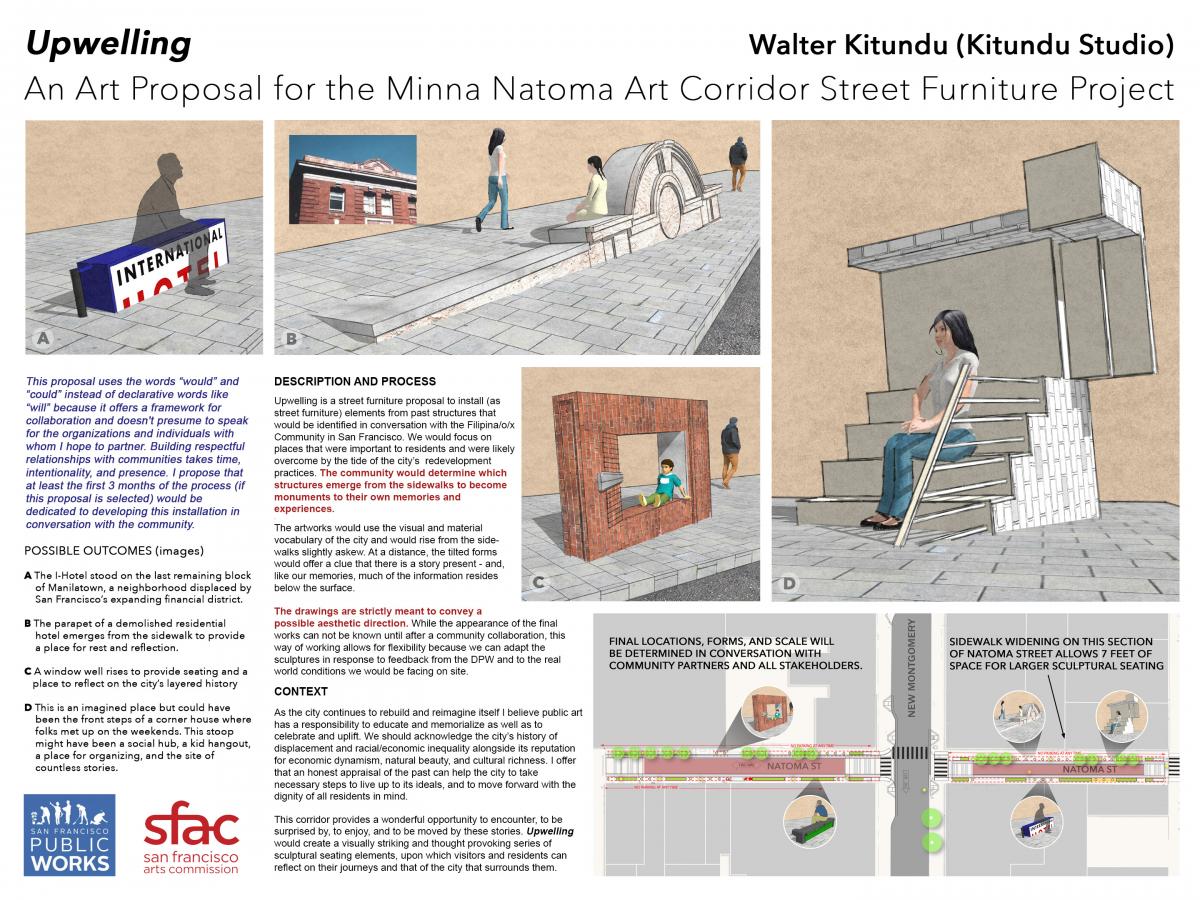 ~ This proposal uses the words “would” and “could” instead of declarative words like “will” because it offers a framework for collaboration and doesn't presume to speak for the organizations and individuals with whom I hope to partner. Building respectful relationships with communities takes time, intentionality, and presence. I propose that at least the first 3 months of the process (if this proposal is selected) would be dedicated to developing this installation in conversation with the community.
~ This proposal uses the words “would” and “could” instead of declarative words like “will” because it offers a framework for collaboration and doesn't presume to speak for the organizations and individuals with whom I hope to partner. Building respectful relationships with communities takes time, intentionality, and presence. I propose that at least the first 3 months of the process (if this proposal is selected) would be dedicated to developing this installation in conversation with the community.
DESCRIPTION AND PROCESS
Upwelling is a street furniture proposal to install (as street furniture) elements from past structures that would be identified in conversation with the Filipina/o/x Community in San Francisco. We would focus on highlighting places that reside in collective and individual memory, places that may have been overcome by the tide of the city’s expansion and redevelopment practices. Our shared reflections on history and memory would inform the artworks. The community would determine which structures emerge from the sidewalks to become monuments to their own memories and experiences.
Our talks with organizations and individuals would be supplemented by a thorough research phase. Historical images of the businesses and residential buildings of SOMA, Kearny Street and Manilatown, along with sketches, recollections, and personal snapshots would contribute to the development of accurate versions of once existing structures.
The artworks would use the visual and material vocabulary of the city and would rise from the sidewalks slightly askew. Even from a distance, the tilted forms would offer a clue that there is a story present - and, like our memories, much of the information resides below the surface.
While some of the memories may be joyful, some of the places that arise may have been lost or transformed only recently and people may still be grieving those losses. There is often a tendency to historicize events and relegate them to the distant past when the people that lived through them are still with us. The story of a city can be found with its residents and it’s my hope that through our dialogues we can create a beautiful installation that would uphold and honor those stories.
MAINTENANCE AND MATERIALS
Maintenance would be minimal since the structures are built from the same materials, and with the same proven techniques, as the buildings already present in the urban environment. The works would shed water well since most surfaces would be sloped in relation to the ground plane.
Due to the nature of this proposed process the final dimensions, locations, materials, colors, are not yet determined. We would work with the limitations and advantages offered by the setting.
Care would be taken to avoid trip hazards, enclosures that could collect refuse, and to maintain important sight lines for pedestrians and vehicles.
All elements of the installation are meant to work as street furniture and would be reviewed to ensure they meet or exceed ADA requirements. It should be possible to adapt the forms with back or armrests when required.
The drawings are strictly meant to convey an aesthetic direction while allowing for flexibility in scale, final content, and materials. While the appearance of the final works can not be known until after a community collaboration, this way of working does allow for flexibility because we can adapt the sculptures in response to feedback from the DPW and to the real world conditions we would be facing on site. The artworks can adjust to address any engineering, placement, scale, and public safety issues. The works can also be “built to scale” as available resources for the project become known.
A NOTE
I recognize that we are asking for approval of an artwork that would almost certainly be different from the images presented in this proposal. In order for this to be a reasonable request, one must believe that community members have a wealth of stories and experiences that could provide the basis for a public art installation that is moving, memorable, and delightful. And, that Kitundu Studio has the ability to facilitate this community design process in order to create compelling, lasting work for the public realm. Both of these things are true.
My experience as an artist, designer, and fabricator will ensure that the stories and structures that emerge from this collaborative process have both the aesthetic and structural integrity appropriate for this installation. That means seriously addressing accessibility, safety, longevity, maintenance and materials while creating artworks that are both thought provoking and lovely.
CONTEXT
San Francisco is often lauded as being comparatively progressive. The city continues to rebuild and reimagine itself. I believe public art bears a responsibility to educate and memorialize as well as to celebrate and uplift. We should acknowledge the city’s history of displacement and racial/economic inequality alongside its reputation for economic dynamism, natural beauty, and cultural richness. This complexity is what constitutes the identity and history of this metropolis. I offer that an honest appraisal of the past can help the city to take necessary steps to live up to its ideals, and to move forward with the dignity of all residents in mind.
Art is just one tool for moving in that direction. There is such beauty in the lived experience of San Francisco’s residents. This corridor between the Transit Center and the museum, shopping and conference areas provides a wonderful opportunity to encounter, to be surprised by, to enjoy, and to be moved by their stories. Upwelling would create a visually striking and thought provoking series of sculptural seating elements, upon which visitors and residents can reflect on their journeys and that of the city that surrounds them.
View a larger image of the proposal
Untitled
Masako Miki
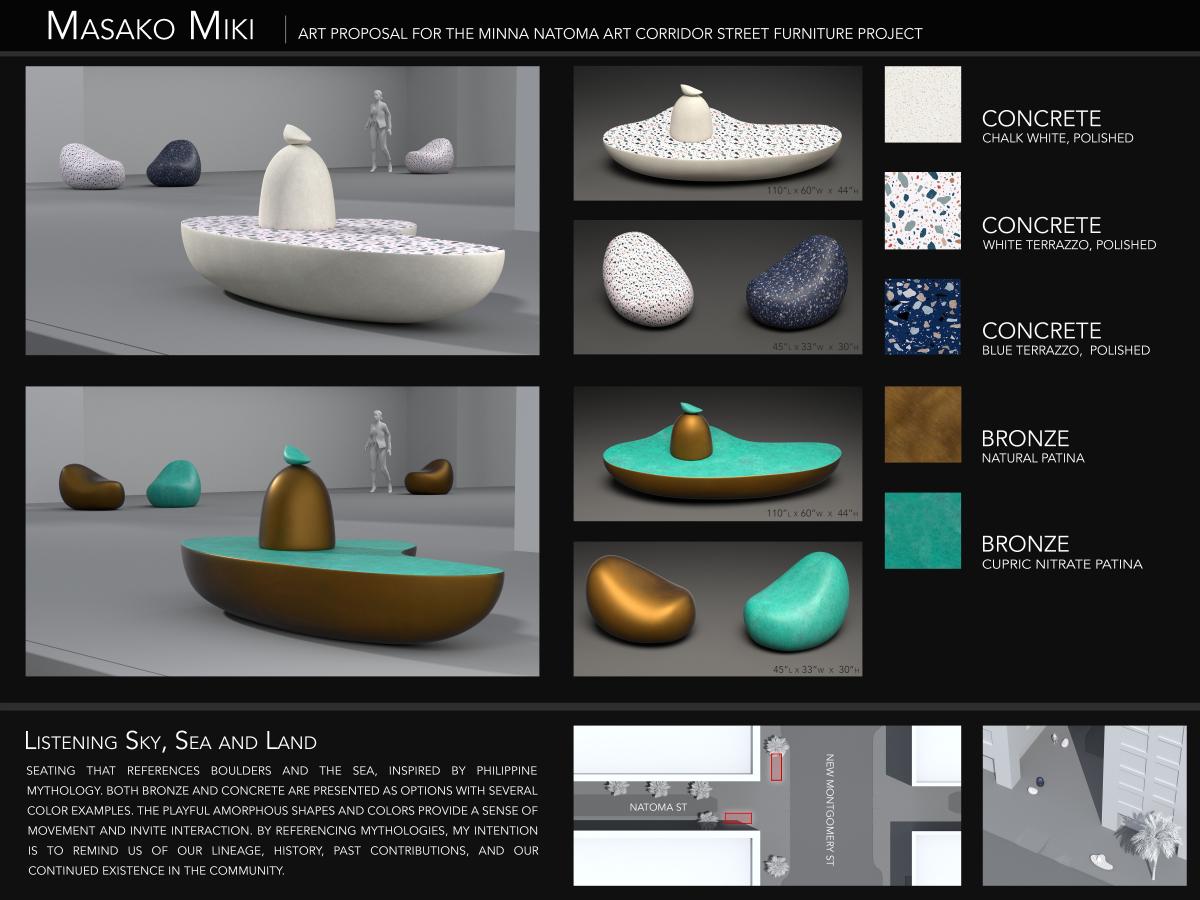 Basic concepts:
Basic concepts:
My shapeshifter series began as an investigation of my own dual Japanese and American identities, and later reconnected with animistic Shinto traditions to articulate my evolving cultural identity. Shapeshifters are a recurring symbol within ancestral Japanese mythologies and folklore, often manifesting the synthesis of opposing dualities. The boundless nature of Shinto shapeshifters generates new identities and intersections within the idea of selfhood as they continuously shift shapes through their existences. My current work revisits these mythologies and recontextualizes them within a contemporary society in which concepts of racial, cultural, gender, sexual and national identities have evolved and expanded.
For this project, I wanted to design two benches inspired by Philippine mythology. The South of Market has been home to Filipino immigrants and Filipino Americans for decades. I feel this is an opportunity to honor and re-recognize their history and unique cultures. I also believe that sharing the specific Philippine mythologies resonates with the larger idea about celebrating our diversity. Indigenous Philippine mythologies share uniquely diverse influences from many cultures like Hindu, Muslim, Shinto, Buddhist, and Christian traditions. I find this is an important narrative to generate because we are a nation of immigrants.
was drawn to two particular Philippine mythologies. One is a cosmogony of Tagalog, which is a story about a sacred bird that caused the sky and the sea to war. The sky threw boulders onto the sea and formed islands. In one particular iteration, the bird built a nest on an island and left the sky and sea in peace. For my large bench design, I imagined the sitting surface as the sea. The bench includes the protruding boulder with the sacred bird resting on top. For concrete, I selected white with terrazzo tiles on the sitting surface to express the flickering reflection of the sea. For bronze, I selected different patina finishes to conjure natural textures and colors of the boulder and water.
I also designed a small seat. The alleyways of Natoma-Minna Street are intimate and narrow. I wanted to create a smaller seat to be placed in a different proximity. Two or three seats can be installed in a close grouping, or individually for more space. The configuration of seats is flexible for spacing and quantity. These seats reference the boulders in the story. For concrete, I also wanted to add terrazzo tiles as textures. I have white and navy as base colors with multiple colors of terrazzo tiles inlayed. For bronze, I will use a green and natural bronze patina finish to express the colors and textures of land and sea.
My inspiration for the bollard design came from the Mandaya of pre-colonial Mindanao, which is a story of the sun and the moon. There are many versions of the story, but they generally center on a quarrel between the sun and moon. The sun and the moon had many children, and after their children passed, they were chopped up and the sun scattered them in the sky. Some versions described these fragments becoming fish, animals, and lands, but the ones that fell upward remained in the sky as stars. I designed three shapes: two spheres representing the sun and the moon, and an ellipse representing the stars in the sky. I propose two different configurations of three shapes, but I can offer more variations if desired. For concrete, I plan to use different colors with small terrazzo tiles for the sun and the moon, and larger terrazzo tiles for the sky to express the bursting stars. For bronze, I will use different patina finishes for the sun and the moon, and more visible patina patterns for the ellipse with the stars.
The SOMA area represents Filipino immigrants’ and Filipino Americans’ complex history including their struggles and accomplishments to build a community while maintaining their self-identity. Referencing cosmogony myths is a reminder of one’s history of creating a new home. As an immigrant artist from Japan, I believe introducing cultural narratives leads to our visibility in the community. Many of our previous generations made enormous contributions to building the nation, and generations continue to do so while preserving traditions. I truly hope that these symbolic mythologies remind us of our lineage, past contributions, and our continued existence.
I was also drawn to these mythologies because they share animistic beliefs. I believe that animism expresses the idea of non-human centric perspectives of the universe. Everything in the universe is sacred because spirituality exists within materiality. Nothing is considered insignificant; everyone and everything is imbued with spirit. In many ancient animistic mythologies, humans respected our relationships and connections to the natural world. A unique sensibility of nostalgia is experienced in Shinto animism. This can be further illuminated by the etymology of the word “nostalgia” itself: in Greek, “nostos” means return or home, “algos” means ache and pain. It is our collective feelings of aching to be home in the natural world. Though we live every day in the natural world, we have become distant and disconnected due to our exploitative relationship with nature. Thinking about this from a non-human centric perspective can remind us more about our humanity and the future identity of ourselves as species.
The bike rack is inspired by my on-going motif of extended hands. Connecting Shapeshifter is my invented shapeshifter. Shapeshifters in my work are a signifier of new independent identities. This particular motif is inspired by the idea of collaboration and connection. For both concrete and bronze, I am using one color or one patina finish.
I hope my designs invite meaningful reflections and acknowledgement of history. As a collective, we continue to make efforts to build homes for all who have been here, and will be here in the future. These designs are a celebration of the empathy and resiliency of that endeavor.
Proposed Locations:
My designs are flexible and can be installed at both the Minna and Natoma location. For this proposal, I placed the large bench at the intersection of Natoma and New Montgomery, where the PDF plan view indicates the widest pedestrian area. And I used Natoma Street’s alleyway for the small seats, bollards, and bike rack.
View a larger image of the benches
Untitled
Jesse Schlesinger
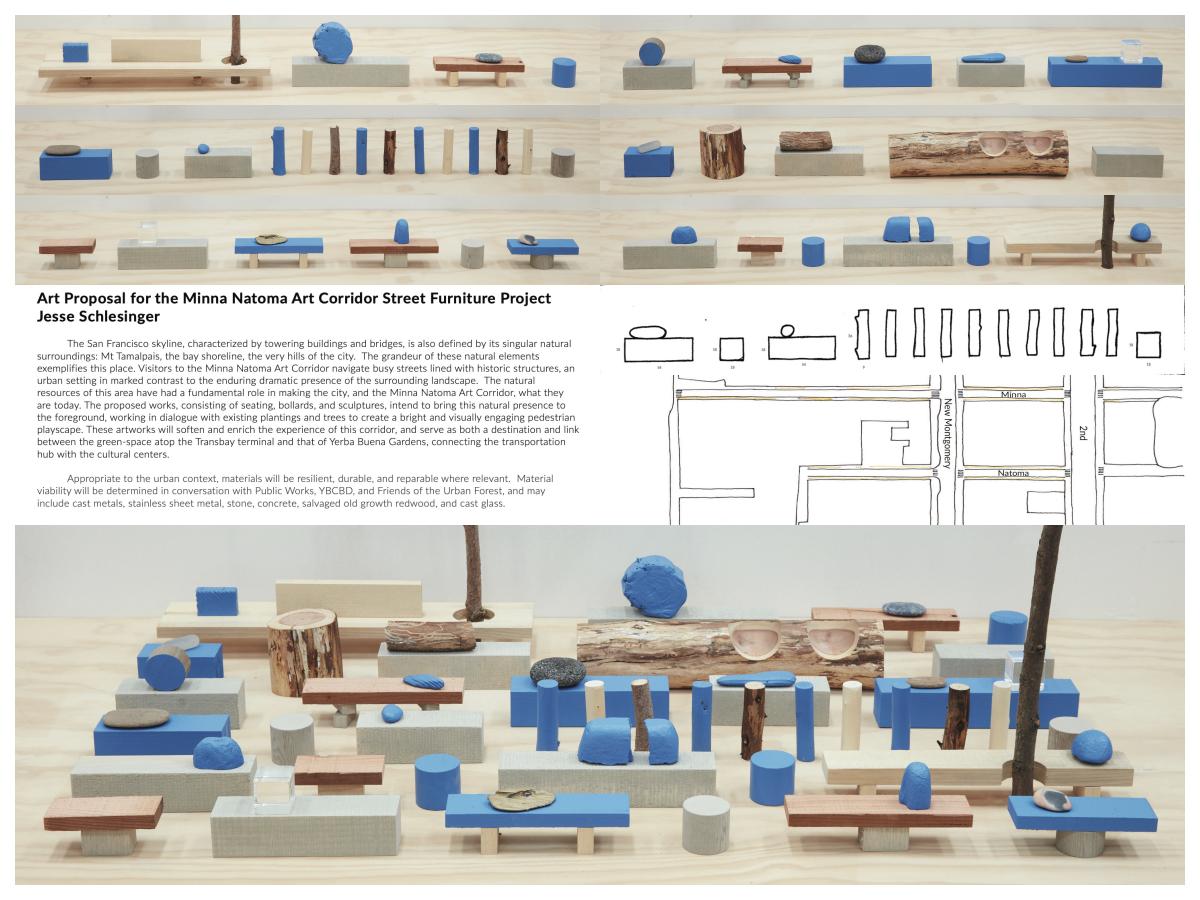 The San Francisco skyline, characterized by towering buildings and bridges, is also defined by its singular natural surroundings: Mt Tamalpais, the bay shoreline, the very hills of the city. The grandeur of these natural elements exemplifies this place. Visitors to the Minna Natoma Art Corridor navigate busy streets lined with historic structures, an urban setting in marked contrast to the enduring dramatic presence of the surrounding landscape. The natural resources of this area have had a fundamental role in making the city, and the Minna Natoma Art Corridor, what they are today. The proposed works, consisting of seating, bollards, and sculptures, intend to bring this natural presence to the foreground, working in dialogue with existing plantings and trees to create a bright and visually engaging pedestrian playscape. These artworks will soften and enrich the experience of this corridor, and serve as both a destination and link between the green-space atop the Transbay terminal and that of Yerba Buena Gardens, connecting the transportation hub with the cultural centers.
The San Francisco skyline, characterized by towering buildings and bridges, is also defined by its singular natural surroundings: Mt Tamalpais, the bay shoreline, the very hills of the city. The grandeur of these natural elements exemplifies this place. Visitors to the Minna Natoma Art Corridor navigate busy streets lined with historic structures, an urban setting in marked contrast to the enduring dramatic presence of the surrounding landscape. The natural resources of this area have had a fundamental role in making the city, and the Minna Natoma Art Corridor, what they are today. The proposed works, consisting of seating, bollards, and sculptures, intend to bring this natural presence to the foreground, working in dialogue with existing plantings and trees to create a bright and visually engaging pedestrian playscape. These artworks will soften and enrich the experience of this corridor, and serve as both a destination and link between the green-space atop the Transbay terminal and that of Yerba Buena Gardens, connecting the transportation hub with the cultural centers.
Appropriate to the urban context, materials will be resilient, durable, and reparable where relevant. Material viability will be determined in conversation with Public Works, YBCBD, and the Bureau of Urban Forestry, and may include cast metals, stainless sheet metal, stone, concrete, salvaged old growth redwood, and cast glass.
Redwood (Sequoia Sempervirens) is endemic to this region and, as such, serves as an elegantly complex symbolic representation of this place. I propose sculptures that utilize or directly reference this material, and where possible, I would like to use salvaged old growth, potentially harvested from recent fires. I am interested in large diameter redwood timbers for sculptural seating, as this inherently impressive scale will create a dynamic presence along the street. Tight grained old growth wood will be nearly as resilient as other materials, will develop a beautiful patina, and can potentially be repaired easily. That said, in consideration of maintenance, the redwood will primarily be used as source material for works in cast metal or concrete.
While the proposed materials possess potential for an inherently beautiful natural patina, others will be finished with color to playfully engage the viewer's perceptions. In contrast to the more muted tones in the rest of the work, color also presents an opportunity for the visitor to reflect on assumptions of natural and artificial, and encourages an increased awareness of both natural and manmade surroundings. Thus the presence of bright blue in the works supplies a welcoming tone and conceptual counterpoint, along with a unifying marker for wayfinding. The blue color also references the long standing Filipino cultural presence in the neighborhood, drawing from the peacetime national flag of the Philippines, along with the natural presences of the sky, bay, and ocean.
Two examples in the model describe seating that draws a direct relationship between the furniture and the trees specified in the current site plan. These benches will partially or fully encircle the trees, with design finalized in conversation with Public Works, YBCBD, and the Bureau of Urban Forests. This will ensure that the artworks do not restrict growth or impede access to the trees, but may instead serve to protect them. The relationship between the tree and the bench highlights the dynamic between the urban and natural environment, with Joseph Beuys' 7,000 Oaks (originally at Documenta nearly 40 years ago!) a welcome precedent in its complex and timely ideas simply executed.
Though many examples of form and material options are presented in the model, these choices may be narrowed to better suit the needs of the site as determined by project partners and advisers, as well as project scope, budget, and other parameters.
View a larger image of the proposal
Ban the Bomb
Pedro Reyes
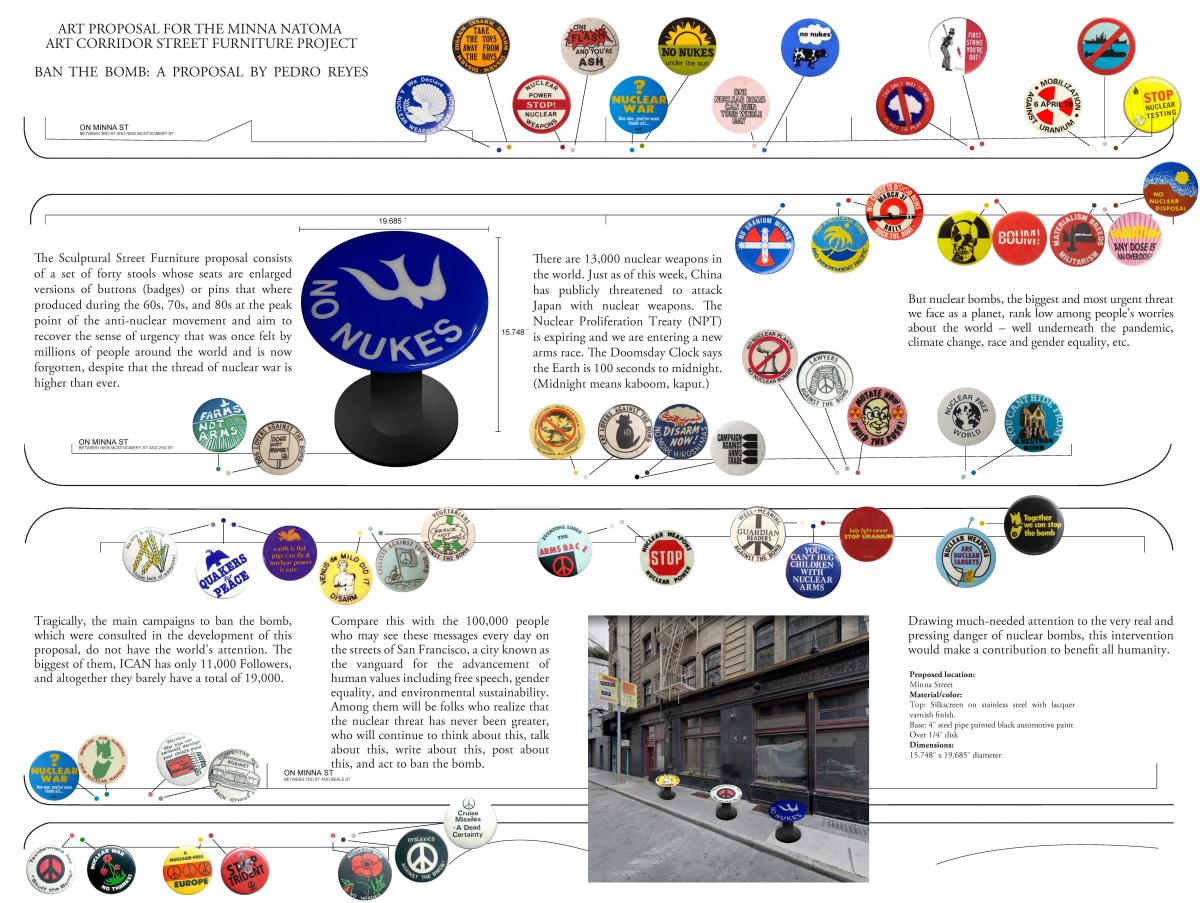 The Sculptural Street Furniture proposal consists of a set of forty stools whose seats are enlarged versions of buttons (badges) or pins that where produced during the 60s, 70s, and 80s at the peak point of the anti-nuclear movement and aim to recover the sense of urgency that was once felt by millions of people around the world and is now forgotten, despite that the thread of nuclear war is higher than ever.
The Sculptural Street Furniture proposal consists of a set of forty stools whose seats are enlarged versions of buttons (badges) or pins that where produced during the 60s, 70s, and 80s at the peak point of the anti-nuclear movement and aim to recover the sense of urgency that was once felt by millions of people around the world and is now forgotten, despite that the thread of nuclear war is higher than ever.
There are 13,000 nuclear weapons in the world. Just as of this week, China has publicly threatened to attack Japan with nuclear weapons. The Nuclear Proliferation Treaty (NPT) is expiring and we are entering a new arms race. The Doomsday Clock says the Earth is 100 seconds to midnight. (Midnight means kaboom, kaput.)
But nuclear bombs, the biggest and most urgent threat we face as a planet, rank low among people’s worries about the world – well underneath the pandemic, climate change, race and gender equality, etc.
Tragically, the main campaigns to ban the bomb, which were consulted in the development of this proposal, do not have the world’s attention. The biggest of them, ICAN has only 11,000 Followers, and altogether they barely have a total of 19,000.
Compare this with the 100,000 people who may see these messages every day on the streets of San Francisco, a city known as the vanguard for the advancement of human values including free speech, gender equality, and environmental sustainability. Among them will be folks who realize that the nuclear threat has never been greater, who will continue to think about this, talk about this, write about this, post about this, and act to ban the bomb.
Drawing much-needed attention to the very real and pressing danger of nuclear bombs, this intervention would make a contribution to benefit all humanity.
View a larger image of the proposal
Rest and Play
Rayyane Tabet, Dasha Khapalova, Peter Ballman
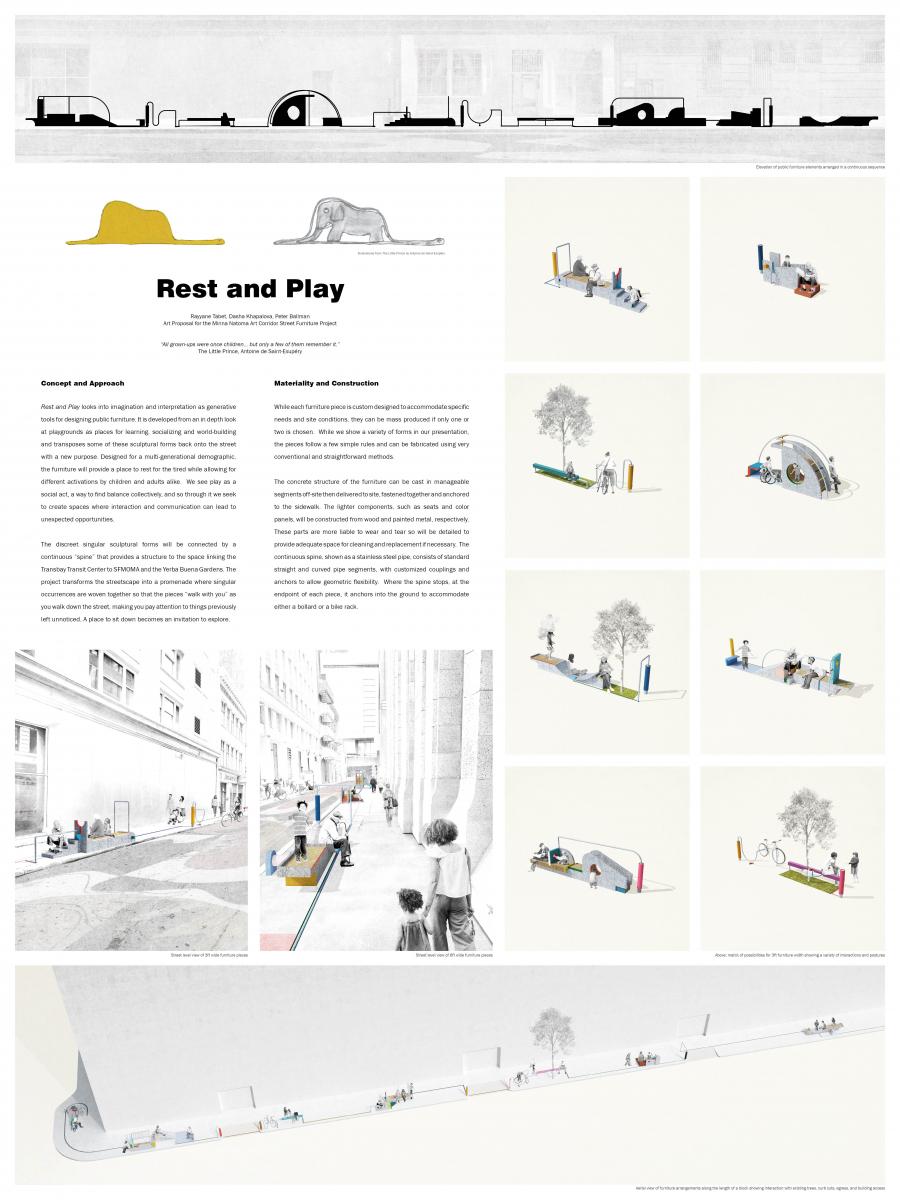 “All grown-ups were once children… but only a few of them remember it.”
“All grown-ups were once children… but only a few of them remember it.”
The Little Prince, Antoine de Saint-Exupéry
Concept
The 1943 book The Little Prince, opens with a discussion on the nature of grown-ups and their inability to perceive "important things". As a test to determine if grown-ups are as enlightened as children, the narrator shows a picture depicting a snake that has eaten an elephant but to the grown-ups it is just the drawing of a hat.
Rest and Play looks into imagination and interpretation as generative tools for designing public furniture. It is developed from an in depth look at playgrounds as places for learning, socializing and world-building and transposes some of these sculptural forms back onto the street with a new purpose. Designed for a multi-generational demographic, the furniture will provide a place to rest for the tired while allowing for different activations by children and adults alike. We see play as a social act, a way to find balance collectively, and so through it we seek to create spaces where interaction and communication can lead to unexpected opportunities.
The discreet singular sculptural forms will be connected by a continuous “spine” that provides a structure to the space linking the Transbay Transit Center to SFMOMA and the Yerba Buena Gardens. The project transforms the streetscape into a promenade where singular occurrences are woven together so that the pieces accompany you as you walk down the street, making you pay attention to things previously left unnoticed. A place to sit down becomes an invitation to explore.
Approach
Because of the particularities of the site condition, we have proposed different options for the sculptural elements that respond to the animated nature of the street. We see these pieces as wholly integrated into the context of existing elements, making sense of them and turning the problematic and irregular into an ideal condition.
By providing several types, our idea is to show the flexibility rather than rigidity within the concept, and its many possible manifestations. These elements vary from the simple to the complex and can be adjusted as needed. Through playfulness and imagination, even restrictions such as existing site conditions, safety and egress requirements, fire access and so on can become opportunities to create something new, beautiful and fun.
Each piece of furniture provides possibilities for different postures of sitting and rest as well as more active uses. Functional elements needed on the street such as trees, curb cuts, loading docks and signage are integrated into the proposed forms so that the pieces acquire more complex dimension and use. Similarly, the proposed continuous spine includes bollards, bike racks and takes on different manifestations as it travels through the street.
Process
We have designed elements that are 3’ and 6’ in width to show the variety and complexity of possible forms, functions and usage within the given dimensional constraints. This presentation is meant to show the many possibilities and permutations of one concept, with the idea that even if two or three of these were implemented, the spirit of the project could still be realized.
Since we were working without a confirmed budget and with limited restrictions, we chose to go as far as we could to illustrate the idea, creating a matrix of possibilities and imagining how they could all be strung together to create a concentrated, full experience. We expect the process to be a collaboration with the several partners involved and understand that, if selected, many limitations would come into play. We welcome the opportunity to fine tune and adjust the pieces to adequately reflect the needs of the community and the logistics of the city.
Construction
While each furniture piece is custom designed to accommodate specific needs and site conditions, they can be mass produced if only one or two is chosen. While we show a variety of forms in our presentation, the pieces follow a few simple rules and can be fabricated using very conventional and straightforward methods.
The concrete structure of the furniture can be cast in manageable segments off-site then delivered to site, fastened together and anchored to the sidewalk. Connection details will prioritize ease of maintenance and serviceability. The lighter components, such as seats and color panels, will be constructed from wood and painted metal, respectively. These parts are more liable to wear and tear so will be detailed to provide adequate space for cleaning and replacement if necessary. Note that while concrete has been chosen for its stability and durability, these forms could easily be realized in a cheaper or lighter material such as wood.
The continuous spine, shown as a stainless-steel pipe, consists of standard straight and curved pipe segments, with customized couplings and anchors to allow geometric flexibility. Where the spine stops, at the endpoint of each piece, it anchors into the ground to accommodate either a bollard or a bike rack. Here the spine can continue in the sidewalk as a line, as a score in the concrete, a drain, or simply a painted line to resonate with the adjacent street mural. This spine can also move around existing conditions, such as the trees shown on our presentation boards. While no plantings are included in the proposed furniture pieces, there is the flexibility to incorporate them or work around them as needed.
View a larger image of the proposal
For more information,
Please contact: jill.manton@sfgov.org, or (415) 252-2226.
Materiales traducidos están disponibles para usted de manera gratuita. Para asistencia, notifique a jill.manton@sfgov.org, or (415) 252-2226..
我們將為閣下提供免費的書面翻譯資料。 如需協助, jill.manton@sfgov.org, or (415) 252-2226..
Ang mga materyales na nakasalin sa ibang wika at ang mga serbisyong tagapagsalin sa wika ay walang bayad. Para sa tulong, maaring i-contact si jill.manton@sfgov.org, or (415) 252-2226.

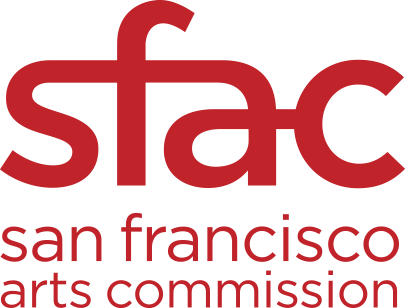

Opportunity For Public Comment
Please take a few minutes to review these artwork proposals to provide public comment. Public comments will be considered as part of the Final Review Panel meeting where the Panel members will recommend two proposal for implementation. The proposals are available online at www.sfartscommission.org/calendar, in the Public Art Proposal Display section or comments may be emailed to sfacpublicartcomment@sfgov.org by Wednesday, August 9th, 2021 at 5:00 p.m.
The Final Review Panel meeting will take place virtually on Thursday, August 12, 2021, 2:00 p.m. – 6:00 p.m. and will be open to the public to attend. An agenda for the meeting will be posted 72 hours in advance on SFAC’s website under the Public Meeting section: www.sfartscommission.org along with instructions on how to join the meeting virtually. Please note that public comments do not constitute a vote.